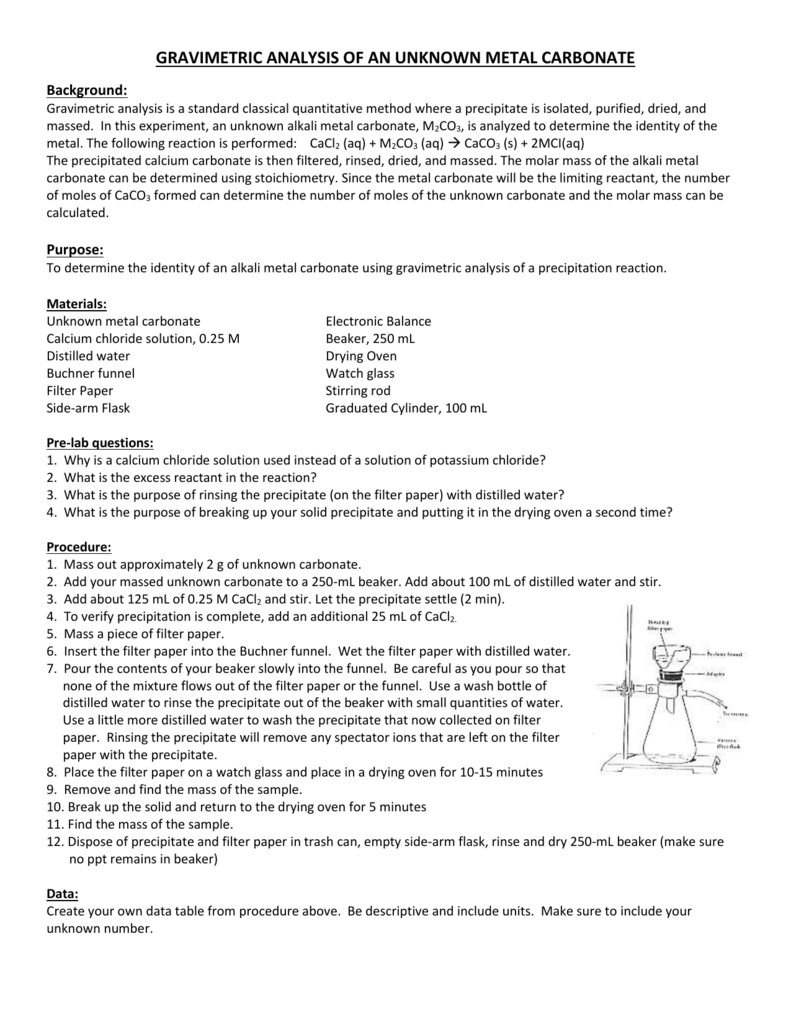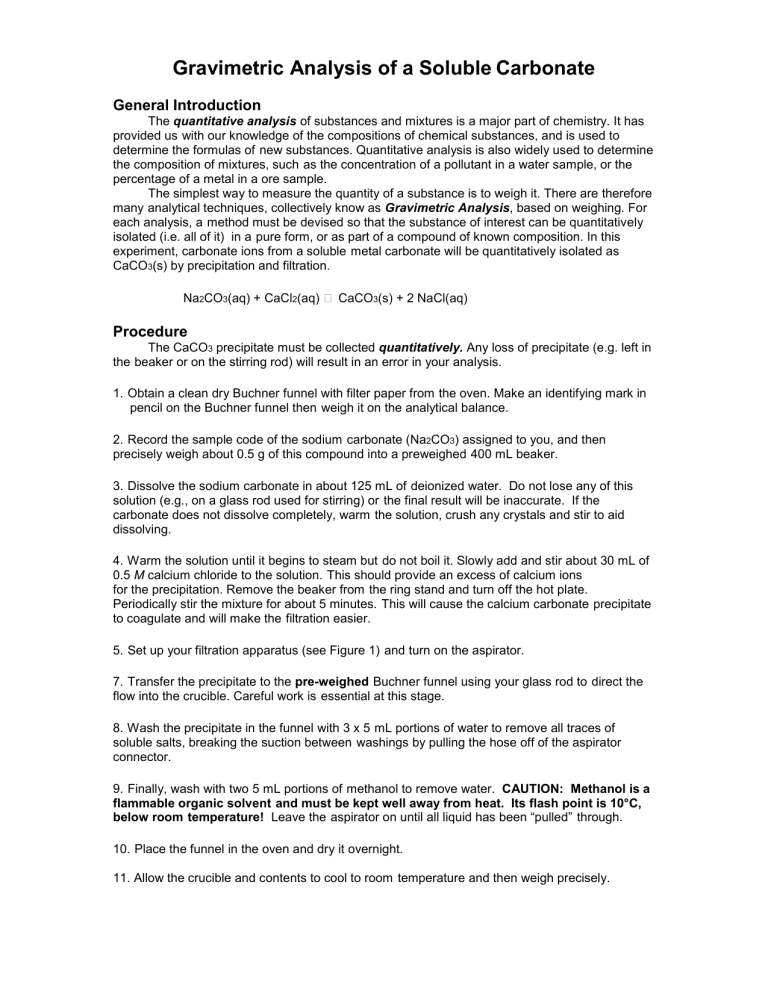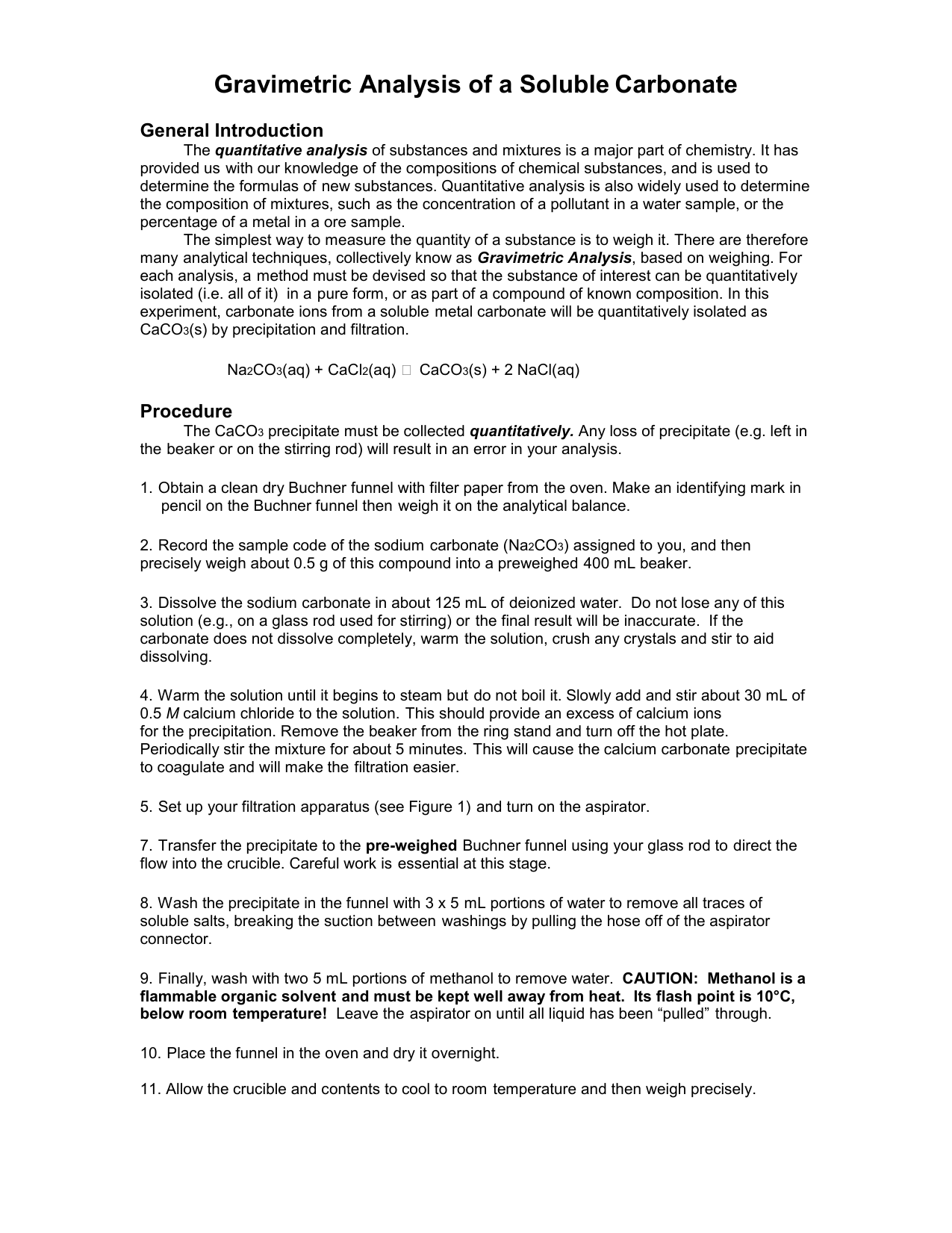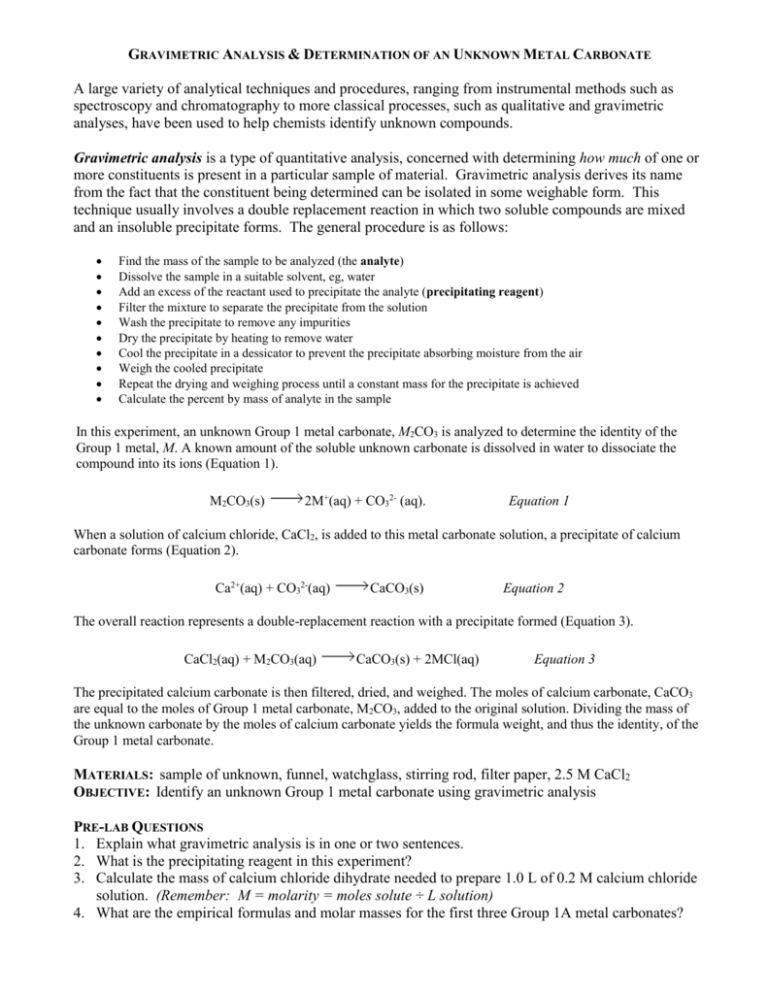Gravimetric Analysis of Calcium Carbonate Lab
Rather than enjoying a good book with a cup of tea in the afternoon instead they cope with some harmful virus inside their laptop. It can completely neutralize stomach acid.

Gravimetric Analysis Of An Unknown
Analysis of calcium lab but end up in malicious downloads.

. The purpose of this lab is to determine the identity of a Group 1 metal carbonate compound by gravimetric analysis. Using this balanced equation determine the limiting reactant if 15 grams of calcium chloride was reacted with 15 grams of potassium carbonate. Using this balanced equation determine the limiting reactant if 15 grams of calcium chloride was reacted with 15 grams of potassium carbonate.
Lab 4 Gravimetric Analysis of a Metal Carbonate adapted from Flinn Scientific ChemFax 2005 Background. Measure about 20 mL of calcium chloride solution. Show all calculations and report in wtv concentration 4.
Gravimetric analysis with calcium chloride and potassium carbonate Data Sheet. In this lab we will determine the identity of a group 1 metal carbonate compound by gravimetric analysis. Mass of CaCl2 after 24 Hours Post-Lab Questions.
EXPERIMENTAL The first step in the gravimetric titration lab is to measure and collect the mass of salt which the professor indicates that it could either be potassium or sodium carbonate. Dividing the mass of the unknown carbonate by the moles of CaCO3 will yield the molar mass of M2CO3. In this experiment an unknown alkali metal carbonate M 2CO 3 is analyzed to determine the identity of the metal.
A bottle containing an alkali metal and carbonate M 2 CO 3 is unlabeled in the stock room. Ca2aq C2O42-aq H2Ol CaC2O4 H2Os After the precipitate is formed we have to filtrate it out of the solution. The Essay on Ap Chemistry Gravimetric Lab.
The moles of CaCO3 is 001828 because the mass of CaCO3 is 1830 grams therefore in order to get the moles of CaCO3 we must divide 1830 by the molar mass of CaCO3 which is 1001. Using gravimetric analysis it has been determined that the unknown Group 1 metal carbonate compound is K2CO3 potassium carbonate. The precipitate is filtered dried and weighed.
This lab in particular uses the following reaction to convert calcium to a large isolatable crystal. Access Free Gravimetric Analysis Of Calcium Lab analysis. Calcium Carbonate CaCO3 Calcium Carbonate chalk is the most potent usable antacid.
There are three main parts to the gravimetric analysis. Access Free Gravimetric Analysis Of Calcium Lab weight measurement of damp powder is one example of the experiments. Data and Observations Table 6.
Gravimetric Determination of Calcium as CaC 2 O 4. D use your yield of calcium carbonate to determine the experimental Analyze the data an concentration of calcium chloride in the solution that you made in steps 6 and 7. View Lab Report - 22539C7A-F61C-4A5B-B525-2B0D142A8E95jpeg from CHEM 101 at Saint Marys College of California.
To determine the concentration of an unknown solution of CaC2O4 by gravimetric analysis method. Base d on your yield of calcium carbonate calculate the mass of calcium present in the original solution. Using the last mass measured do not average the masses from all the heatcoolweigh cycles calculate the moles of CaC2O4H2O in each filtration funnel.
The first is the species must be converted to an insoluble compound. We did that in this lab by pouring the solution through a vacuum filtration system. The book is a manual that guides a student to the correct ways of conducting an experiment made on.
Gravimetric Analysis of a Metal Carbonate Context. A solution of calcium chloride is added to the metal carbonate solution to precipitate the carbonate ions as calcium carbonate. Gravimetric Analysis of a Metal Carbonate Lab 4 Data Table Observations Mass of.
From the data the formula weight and identity of the unknown metal carbonate. Mass of CaCl2 after 24 Hours. Add 2g of unknown carbonate to the crucible and place on the triangle.
Various water softening techniques are used to remove the cations responsible for water hardness. Set up the Bunsen burner and ring clamp light the burner and heat the crucible. Gravimetric analysis of calcium lab is available in our book collection an online access to it is set as public so you can download it instantly.
He tears out and zero the balance while having a. Calculate the average molarity of Ca2in the unknown solution. After the sample precipitates were dried and weighed the calcium carbonate masses and theoretical water hardness mgL obtained were used to calculate the percent yield and average water hardness for each sample.
As rock star AP chemistry students you and your peers will analyze the compound using gravimetric analysis and determine the identity of the metal. Based on procedures from Standard Methods and Methods for Chemical Analysis of Water and Waste EPA and other pertinent references the Water and Wastewater Examination Manual is an excellent complement to these references-that you will want to keep at your fingertips. The unknown is weighed and dissolved in water.
About one-third of the administered calcium is absorbed and high blood calcium or calcium-containing kidney stones are slight risks. The Ksp determines this. Add the CaCl2 solution to the metal carbonate in the 100 mL beaker and stir w glass rod.
Mass 1 g of the metal carbonate in a 100 mL beaker. By filtering and weighing the carbonate after it has precipitated the mass and moles of CaCO3 could then be found. Gravimetric analysis with calcium chloride and potassium carbonate Data Sheet.
As well as to learn how. Gravimetric Analysis of Calcium and Hard Water Lab Introduction. With these values a molar mass of M2CO3 can be found.
From the data the formula weight and identity of the unknown metal carbonate is determined. Nonetheless it is not always the best choice for regular use. The main concept used in this lab is gravimetric analysis which uses masses of reactants and products to determine properties of a substance1.
The unknown is weighed and dissolved in water and the precipitate is filtered dried and weighed. A known amount of the soluble unknown carbonate is dissolved in water to dissociate the compound into ions Equation 1. Dividing the mass of the unknown carbonate by the moles of calcium.
Data and Observations Table 6. In certain areas of the country the presence of hard water poses significant problems in water supply systems. Report the standard deviation and relative standard deviation s x standard deviationaverage.
Add about 20 mL of distilled water to the beaker and stir to dissolve the unknown carbonate. The higher the Ksp the higher the higher the solubility. This yields 001828 moles.
The results produced from this experiment showed that gravimetric analysis was effective suitable for determining water hardness. The moles of calcium carbonate CaC0 3 are equal to the moles of Group 1 metal carbonate M2C03 added to the original solution. Gravimetric Analysis of a Metal Carbonate Lab Objective.

Gravimetric Analysis Of A Soluble Carbonate

No comments for "Gravimetric Analysis of Calcium Carbonate Lab"
Post a Comment